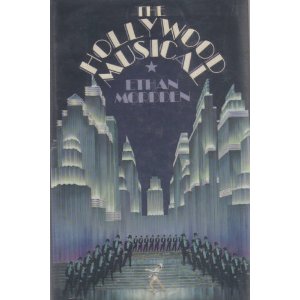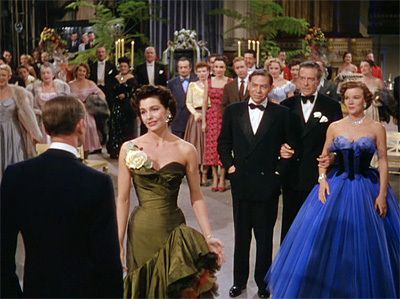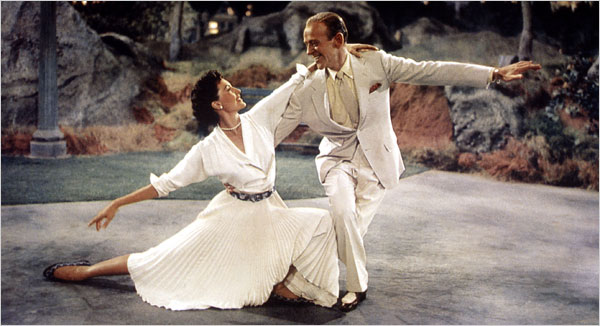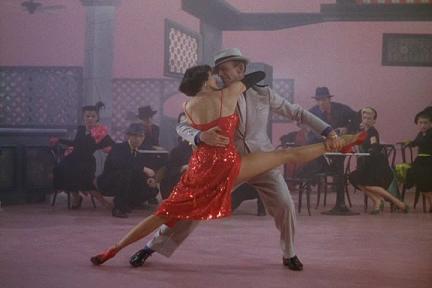From the Summer 1982 issue of Film Quarterly. — J.R.
Four Books on the Hollywood Musical
THE HOLLYWOOD MUSICAL, by Clive Hirschhorn. New York: Crown.
HOLLYWOOD MUSICALS, by Ted Sennett. New York: Harry N. Abrams.
THE HOLLYWOOD MUSICAL, by Ethan Mordden. New York: St. Martin’s Press.
GENRE: THE MUSICAL, edited by Rick Altman. London & Boston: Routledge & Kegan Paul (BFI Readers in Film Studies).
If the musical has nearly been vanquished as a popular form by the increasing subdivision of its audience into separate classes, age groups, and ethnic interests, these four books on the subject which nostalgically chart its heyday are similarly compartmentalized and exclusive. It seems inevitable that each of these four elegant receptacles for the most libidinal of American movie genres should address a different portion of our psyches: after all, if our society and minds are splintered, why shouldn’t our integral genres be as well?
The glib marketing strategies that aim each book at a somewhat different audience create the odd social effect of four high-rises, each constructed inside a separate ghetto — although the attractive coffee table books of Clive Hirschhorn and Ted Sennett might also be regarded with some justice as adjacent towers on somewhere like Sutton Place. The former — by describing in detail 1,344 musicals (a longish paragraph devoted to each) that are listed year by year, then cross-indexed by titles, songs, performers, composers, lyricists, and other creative personnel — is an indispensable reference tool, and, as far as I know, the best of its kind. The latter is of interest chiefly for its beautifully reproduced stills and frame enlargements, many of them in full color—making this book the only pure luxury item in the bunch. Sennett’s critical-survey text, while serviceable and pleasant enough, can’t really compete with the dazzling illustrations, which can only be gaped at or mooned over. (Beneath a big color image of the climax of Carmen Miranda’s “The Lady in the Tutti-Frutti Hat” number in the 1943 THE GANG’S ALL HERE — with the star wedged under an expanding thirty-foot cascade of bananas and flanked on each side by an army of gigantic, Magritte-like strawberries — is a caption that can only rationalize delirium with production anecdotes, amusing yet secondary.)
It’s hard to think of two better books about the musical than Ethan Morden’s and Rick Altman’s; why, then, are they so completely at loggerheads with one another? Mordden’s fund of facts about the musical is encyclopedic, vast, intelligent, and usually on display like an Afghan hound; he doesn’t mind letting you know that he knows such things as how they say “supercalifragilisticexpialidocious” in the German-dubbed versions of MARY POPPINS. Much more important, a sensitivity for and technical grasp of the music in musicals virtually place him in a class by himself. His overall command of information is awesome, yet on a stylistic level of aspiration he often seems to aim at the consistency of chatter rather than of sustained thought—a journalistic trait shared at times by writers such as Stephen Harvey and Vito Russo, predicated on the assumption that, existentially speaking, nothing is important enough to be extended beyond the boundaries of a wisecrack or pithy paragraph. “A string of pearls without a string” is how Eisenstein once described the great Russian formalist Viktor Shklovsky, but a single page of Mordden is often little more than a sack of brightly colored jelly beans: “Lawrence Tibbett invaded a song, John Boles comforted it. Chevalier attended it as if it were a party in his honor.”
At its best, in the short run, this is like the celebrated form of one-shot skeet-shooting practiced by writers like James Agee and Arlene Croce in their reviews and essays. At its worst, particularly over the long haul, it can trivialize its own claims for seriousness with its virtual enslavement to a bantering tone that places everything on the same level of nonimportance. (“How is HALLELUJAH patronizing? True, it doesn’t show us any white oppressors. But you can’t have everything.” Apparently you can’t in prose, either.) The culmination of both strains in Mordden’s writing can be found in the Ethan Mordden Hall of Fame and Disrepute that comes at the end, after a useful discography and bibliography — a jokey, self-indulgent, and campier version of Andrew Sarris’s Pantheon exercises that offers us such gold-plated prizes as “Most Daring Studio” (Paramount), “Least Faithful Adaptation from Broadway” (the 1938 SALLY, IRENE AND MARY), “Best Editing” (ALL THAT JAZZ), “Best Argument from the Right” (THE WIZARD OF OZ), and “Fernando Lamas Award for Best Male Singer Born in Argentina Who Appeared in FOUR JILLS AND A JEEP” (Dick Haymes).
If Mordden singles out THE BAND WAGON as the “Worst Celebrated Film,” his short paragraph on the film in the main text begins to explain why:
A back-stager without the slightest taste of the theatre, it was fashioned by Minnelli, Comden and Green, all stage veterans who should know better, using Schwartz and Dietz standards. The score is great and “The Girl Hunt Ballet,” a Mickey Spillane takeoff for Astaire and Cyd Charisse, amusing. But the story is tired, the attempted burlesque of “serious” musicals rude, Oscar Levant atrocious, and Jack Buchanan as uncharming as when he marred MONTE CARLO back in 1930.
But apart from telling us why Ethan Mordden doesn’t like THE BAND WAGON — which may or may not be meaningful in a separate context — the actual information or insight conveyed in such a summary is surprisingly meager.
Among the references to THE BAND WAGON in the index to the Altman anthology are some insightful remarks about the film by Thomas Elsaesser (in a first-rate 1970 postauteurist study of Minnelli drawn from the Brighton Film Review ), a passing but pointed observation by Alain Masson about the film’s functional uses of nonrealism (in the midst of a brilliant, perverse, and semipersuasive defense of George Sidney translated from Positif ), some brief reflections on the validation of entertainment versus art from Robin Wood in Film Comment, and some detailed psychoanalytical annotations from Dennis Giles in Movie. There’s also a fascinating and original argument by Alan Williams, written expressly for this volume, about the functions of sound recording in the illusionism of musicals, with Fred Astaire’s delivery of the film’s opening number used as a central example; Jane Feuer, in a Quarterly Review of Film Studies article, uses the film to illustrate myths about entertainment (involving spontaneity, integration, and the audience) that crop up in self-reflective musicals; and Martin Sutton, in another original essay, reflects on the movie’s narrative patterns involving isolation (e.g., “By Myself,” Astaire’s opening number) and group acceptance (e.g., “That’s Entertainment”).
“That’s entertainment?” I can hear some of my anti-intellectual, musical-buff colleagues skeptically declaring, on being faced with the diverse investigations of the Altman anthology. All I can say is, I was entertained much of the time—believing, as I firmly do, that entertainment and enlightenment are ideally (if often deviously) interconnected. (As bathtub reading, I would argue that the Mordden and Altman score about equally.) As Alan Williams notes, “Some of the pleasure given by musical numbers might actually be something closer to pseudo-bliss, since the effect, so subtle as to pass generally unperceived, is an implicit loss of coherence of the sustained spectator.” One could almost say that the critical prose of Mordden, Croce, and Kael also implies a loss of coherence through its absence of sustained theory or argument; in this respect, it seems that the musical and this kind of prose are both predicated on the puritanical assumption that pleasure and intelligence (or analysis) are incompatible bedfellows.
Consequently, in the world of these latter writers, the diverse achievements of the authors of the Altman anthology don’t even deserve to be dismissed; instead they are systematically ignored. Thus it seems only logical that in a recent roundup review in The New Yorker, Arlene Croce decried the relative absence of intelligent writing about the musical — rightly pointing to the Mordden as a prize catch — while steadfastly refusing to acknowledge the existence of the Altman book, or any related academic endeavors. It may not be irrelevant to add that Altman’s book takes a swipe at Croce in turn, in its generally useful bibliography by Jane Feuer, when it refers to her classic book on Astaire and Rogers as “a witty and elegant though superficial analysis.” (Alas, the respective professional armor of the journalist and the academic is stronger in both these cases than any sense of allegiance to the unaffiliated reader looking for a good intelligent text on a subject. Croce and Feuer are both witty writers, as it happens, who happen to be answerable to what amounts to rival cults.)
The best so far of the BFI Readers in Film Studies, Genre: The Musical is full of interesting ideas about its subject, and fully deserves a place on my shelf right next to Mordden’s book. Especially helpful are the remarks by Williams and Feuer about the manner in which musicals, to paraphrase Rick Altman, mobilize radical techniques for conservative purposes. When Richard Dyer remarks, in one of the best essays, that entertainment presents what utopia feels like rather than how it would be organized, he’s merely touching on the existence of a social and ideological structure that most journalists would rather adopt (or adapt) than acknowledge, analyze, or contest. Characteristic of this mode is Mordden’s show-bizzy gloss on W. Franklyn Moshier’s The Alice Faye Book in his own bibliography:
Faye and her films are basic to the musical both historically and today on television, and serious students should put some time in here. A good start: turn to page 98 for a still of what Moshier captions as the “distinctive Faye pose.” Try striking this pose yourself, if possible in one of Faye’s costumes. How do you feel?
If Mordden’s bibliography and Feuer’s went out on a blind date, it is difficult to imagine all the comic complications that might ensue. Set those collisions and accommodations to music, and you might even have a hit on your hands. In the meantime, within the mutually exclusive environments fostered by these four books, there is plenty of value to be found in each one. It all depends on what you’re looking for, how you feel, and who you are.
— Film Quarterly 35, no. 4 (Summer 1982)








